Bluetooth-configurable valve
keeps all hands on deck
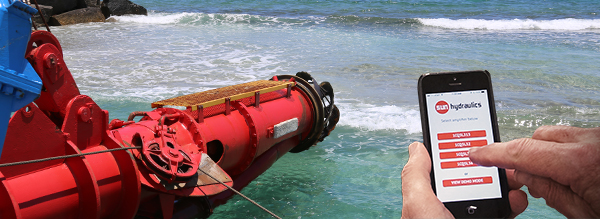 Wireless remote access eliminates laptops, programmers
Wireless remote access eliminates laptops, programmers
and special cabling in this demanding marine application
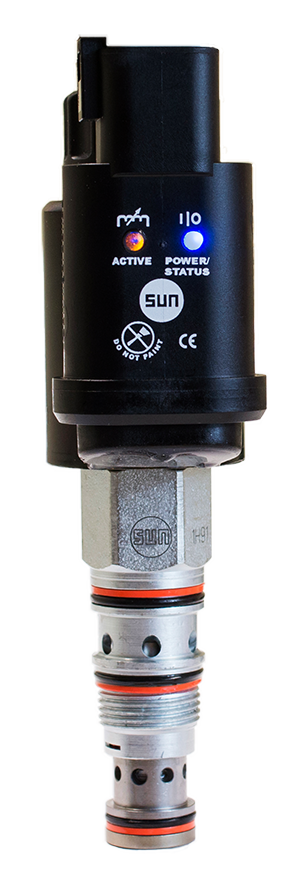
[This article originally appeared in "Hydraulics & Pneumatics Magazine"]
Configuring an electrohydraulic system in a controlled environment is challenging enough, but fine tuning equipment performance in the field presents an additional layer of difficulties. Carrying and maintaining up-to-date specialized equipment and cables, protecting the technician and the equipment from hazardous conditions, accessing difficult-to-reach components — all serve to complicate the process and add time and cost to the operations.
Most often, we think of heavy equipment – agricultural, mining, construction – on site in the middle of nowhere or deep underground. But imagine the challenges of an offshore dredging operation: floating in a sea of corrosive liquid; isolated and basically self-contained; with the hydraulic systems located in a dark, noisy, hot, cramped engine room far from the equipment it controls.
The Application
That’s the situation faced every day by the crew of the offshore dredge at Hillsboro Inlet, on the east coast of Florida. Captain Woodworth “Woody” Draughon – who first started with steam-powered bucket dredges in the Panama Canal as a young man – and Assistant Captain Scott Evans have been working together running the year-round dredging operation at Hillsboro Inlet for more than 20 years. This operation keeps the pass free of sand for both boating traffic and for drainage to prevent inland flooding during storms.
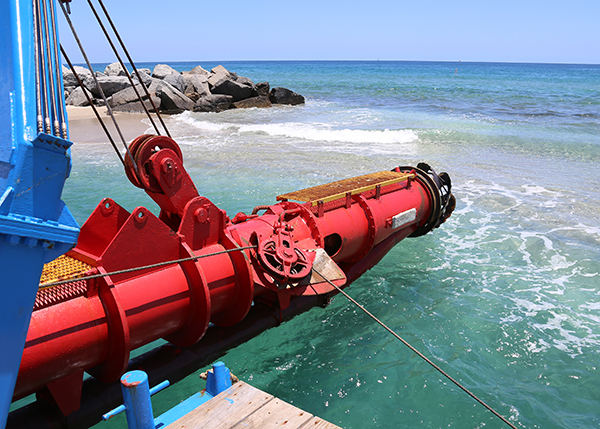 Working on board the custom 1170-S Ellicott Dredge, the crew stays busy running the dredging operation and maintaining the equipment in a hot, salty, humid environment. The dredge includes two diesel engines – the main Caterpillar C-27 and an auxiliary Cat C-9 – that powers a 9,000-gpm pump pushing out 400 cubic yards of sand per hour from the dredge down across the bottom of the pass and out onto a nearby beach to replenish the shoreline.
Working on board the custom 1170-S Ellicott Dredge, the crew stays busy running the dredging operation and maintaining the equipment in a hot, salty, humid environment. The dredge includes two diesel engines – the main Caterpillar C-27 and an auxiliary Cat C-9 – that powers a 9,000-gpm pump pushing out 400 cubic yards of sand per hour from the dredge down across the bottom of the pass and out onto a nearby beach to replenish the shoreline.
Ellicott Dredges, based in Baltimore, Maryland, has worked closely with their local Sun Hydraulics distributor, Advanced Fluid Systems, for the past 25 years. AFS has assisted in the development of cutter heads, ladder circuits, spuds and winch controls for dredges of all sizes. The 1170-S dredge at Hillsboro Inlet uses between 25 and 30 Sun cartridge valves and five Sun coils for control of directional and proportional valves.
The Challenge
One of the Sun valves, an electro-hydraulic proportional valve, controls the swing winch used to adjust the speed of the dredge arm movement and has to be configured to ensure proper operation. Once on board the dredge, you can see the challenges Captain Woody faces when configuring that valve. With the cutter head at the bow of the dredge, the control room two stories up from the deck, and the engine room at the other end of the dredge and down below the deck, the process of fine tuning the valve includes a lot of back and forth, up and down ladders.
The captain has to drag a handheld programmer and cables down into the cramped, dark engine room to the winch control hydraulics, connect physically to the amplifier, step through the settings, then climb back out and up to the control room to operate the controls and view the results of those settings. From start to finish, fine tuning the valve to optimize the winch performance can take hours.
When Sun Hydraulics announced the introduction of the new Bluetooth Embedded Amplifier configured using Sun’s AmpSet Blue™ smartphone app, John Caldwell at Advanced Fluid Systems saw an opportunity. A sales engineer at AFS for more than 25 years, John has worked closely with Ellicott on hydraulic and electrical systems. He knows firsthand the challenge of configuring a new amplifier on these dredges and targeted this application as a perfect example of how this new approach to remote, wireless amplifier configuration could save time, money and effort.
The Product
Sun’s new Bluetooth Embedded Amplifier, the industry’s first commercially available Bluetooth-configurable product, provides a compact, factory-integrated coil and connector combination for use with Sun’s proportional solenoid valves. And yes, there’s an app for that. Users configure the embedded amplifier wirelessly using Sun’s AmpSet Blue™ app on their iOS and Android mobile devices for quick, easy, reliable wireless calibration.
 AmpSet Blue allows users to locate and 'pair' with the selected amplifier using their smart device and to adjust all parameters of the proportional controller through several simple screens. This eliminates the need to carry a separate programmer or expensive laptop with special cables. With the app, users can name each device and save, store, recall, and share settings for future use. For security, the settings of the device can be password protected to prevent tampering by unauthorized individuals.
AmpSet Blue allows users to locate and 'pair' with the selected amplifier using their smart device and to adjust all parameters of the proportional controller through several simple screens. This eliminates the need to carry a separate programmer or expensive laptop with special cables. With the app, users can name each device and save, store, recall, and share settings for future use. For security, the settings of the device can be password protected to prevent tampering by unauthorized individuals.
The amplifier is CE certified to the latest standards including the 30-V/m automotive standard (per Directive 2009/19/EC). Since it is fully encapsulated, sealed to IP69K and offers vibration, shock and environmental protection, it is ideal for installation in harsh environments, including the engine rooms of saltwater dredges.
The Installation
Caldwell contacted Captain Woody, proposed the installation of the new Bluetooth amplifier, and headed south to Hillsboro Beach, Florida. Because it requires no standalone programmer or laptop with special cables, all that was required for a successful installation of this new solution was the Bluetooth amplifier and the captain’s iPhone.
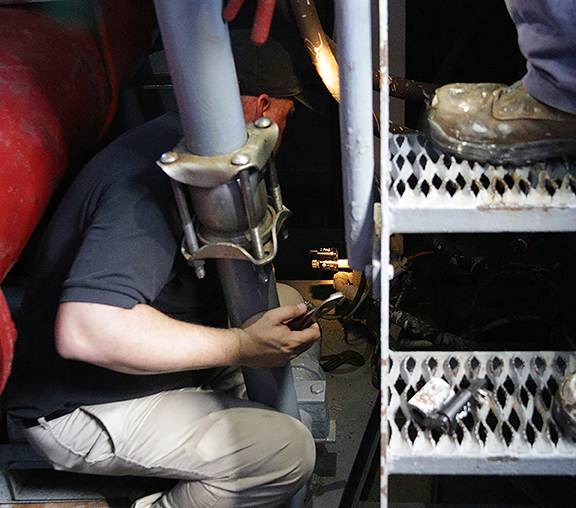 To install the new amplifier, they disconnected the cable connector, removed the installed coil by removing the nut assembly, slid the new Bluetooth amplifier over the installed solenoid valve, tightened the nut and reconnected the cable connector. Time to install: less than five minutes.
To install the new amplifier, they disconnected the cable connector, removed the installed coil by removing the nut assembly, slid the new Bluetooth amplifier over the installed solenoid valve, tightened the nut and reconnected the cable connector. Time to install: less than five minutes.
To configure the amplifier, Captain Woody opened up the App Store on his phone, searched for “Sun Hydraulics,” located the AmpSet Blue™ app and downloaded it to his phone while standing on the deck of the dredge. Time to install: less than five minutes.
Captain Woody walked through the various settings available on the app, then went to the engine room to confirm connection with the amplifier. Every time you open the AmpSet Blue app, it initiates a Bluetooth scan, looking for any Sun Bluetooth amplifiers that are powered up and within range.
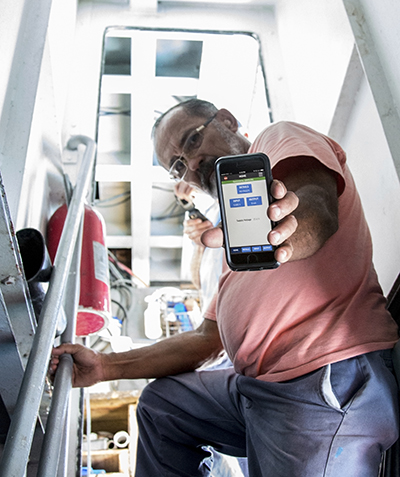 When the captain started the app up, it identified the new amplifier. Once he clicked on the detected amplifier, the app paired with the amplifier, and the status light blinked blue, indicating that connection was made and configuration could begin.
When the captain started the app up, it identified the new amplifier. Once he clicked on the detected amplifier, the app paired with the amplifier, and the status light blinked blue, indicating that connection was made and configuration could begin.
With smartphone in hand, Captain Woody climbed back out of the engine room, up onto the deck of the dredge. His assistant Scott Evans climbed into the control room to start up the diesel, and they began the process of dialing in the settings for the dredge arm. Captain Woody stood on the deck by the bow to observe the behavior of the arm and adjust the settings of the amplifier back in the engine room while Evans operated the arm.
A big challenge with dialing in the settings for this application is in the deadband tuning. In the control room, Evans needed to rotate the potentiometer controlling speed almost half a turn before the dredge arm began to move at all. On the deck in sight of the arm and in communication with Evans, Captain Woody was able to raise the minimum output, allowing higher current from the coil at a lower command voltage and causing the boom to move just after they started to turn the potentiometer. Because of the quick configuration and feedback, the crew was able to set the valve more precisely to their liking, more easily and in less time.
The Result
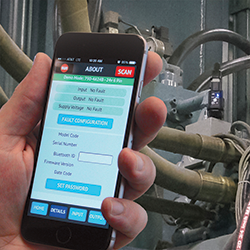 Having wireless remote control of the Sun Hydraulics’ Bluetooth Embedded Amplifier offers a new level of convenience and safety in configuring hydraulic systems in challenging locations. New users can download the AmpSet Blue app with their iOS or Android smartphone that’s already in their pocket, launch the app, pair with the amplifier and begin configuration in minutes.
Having wireless remote control of the Sun Hydraulics’ Bluetooth Embedded Amplifier offers a new level of convenience and safety in configuring hydraulic systems in challenging locations. New users can download the AmpSet Blue app with their iOS or Android smartphone that’s already in their pocket, launch the app, pair with the amplifier and begin configuration in minutes.
For the crew on board the dredge at the Hillsboro Inlet, who spend a lot of their time maintaining their equipment in a warm, humid, corrosive environment, it’s a major benefit to quickly, precisely dial in the dredge arm speed while spending less time in the engine room and less energy climbing up and down the ladders of the dredge.
This new Bluetooth amplifier/app combination opens up opportunities across a broad range of applications, both mobile and industrial, where cost, reliability, ease of use and security are critical. Add to that its noise compliance and robust environmental protection, and you have a solution for many of today’s most challenging electro-hydraulic applications.
The Back Story
Ellicott Dredges, based in Baltimore, is the largest dredge manufacturer in the U.S. and has been building dredges since 1885. They supplied all the dredges used in the original construction of the Panama Canal. Focused on cutter suction dredges, their largest dredge has an output of 2,000 cubic yards per hour.
Sun is represented in the Baltimore area by Advanced Fluid Systems, who works closely with Ellicott Dredges on hydraulic and electrical system solutions.
Download a PDF of this application story.

